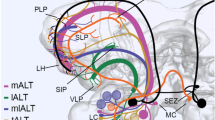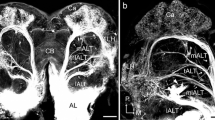Abstract
An ultrastructural study of the antennae of the yellow fever mosquito, Aedes aegypti, revealed that as in the salt marsh mosquito, Culex salinarius, the first flagellar segment of both sexes of A. aegypti contain neuroendocrine cells. These cells not only extend an axon via the antennal nerve to the antennal lobe of the deutocerebrum, but project collaterals to the periphery of the antennae, where they modulate the antennal sensory neurons by forming synapses with the dendrites of these afferent neurons. To our knowledge, this is the first report in any animal of neuroites of neuroendocrine cells forming axo-dendritic synapses with sensory neurons.
Similar content being viewed by others
References
Brown M. R., Klowden M. J., Crim J. W., Young L. A., and Lea A. O. (1994) Endogenous regulation of mosquito host-seeking behavior by a neuropeptide. J. Insect Physiol. 41, 805–813.
Evans P. D. (1994) The effects of myomodulin and structurally related neuropeptides on skeletal neuromuscular transmission in locust. J. Exp. Biol. 190, 253–264.
Fiala J. C. and Harris K. M. (1999) Dendrite structure, in Dendrites (Stuart, G., Spruston, N., and Hausser M., eds.), Oxford University Press Inc., NY, NY, pp. 1–34.
Humason, G.L. (1962) Animal Tissue Techniques. W.H. Freeman, San Francisco, CA.
Kalt M. R. and Tandler B. (1971) A study of fixation of early amphibian embryos for electron microscopy. J. Ultrastruct. Res. 36, 633.
Klowden M. J. (1981) Initiation and termination of host-seeking inhibition in Aedes aegypti during oocyte maturation. J. Insect Physiol. 27, 799–803.
Lundquist C. T., Clottens F. L., Holman G. M., Riehm J. P., Bonkale W., and Nassel D. R. (1994) Locustatachykinin immunoreactivity in the blowfly central nervous system and intestine. J. Comp. Neurol. 341, 225–240.
Maggio J. E. (1988) Tachykinins. Ann Rev. Neurosci. 11, 13–28.
Mclver S. B. (1982) Sensilla of mosquitoes (Diptera: Culicidae). J. Med. Entomol. 19, 489–535.
Meola R. W. and Readio J. (1987) Juvenile hormone regulation of the second biting cycle in Culexpipiens. J. Insect Physiol. 33, 751–754.
Meola S. M., Clottens F. L., Holman G. M., Nachman R. J., Nichols R., Schoofs L., et al. (1998) Isolation and immunochemical localization of three tachykinin-related peptides from the mosquito, Culex salinarius. Neurochem. Res. 23, 189–202.
Meola S. M., Sittertz-Bhatkar H., Pendleton M. W., Meola R. W., Knight W. P. and Olson J. (2000) Ultrastructural analysis of neurosecretory cells in the antennae of the mosquito, Culex salinarius (Diptera: Culicidae). J. Mol. Neurosci. 14, 17–25.
Mollenhauer H. H. (1964) Plastic embedding mixtures for use in electron microscopy. Stain Technol. 39, 111.
Nassel D. R. (1993) Insect myotropic peptides: differential distribution of locustatachykinin-and leucokinin-like immunoreactive neurons on the locust brain. Cell Tissue Res. 274, 27–40.
Nassel D. R., Passier P.C.C.M., Elekes K., Dircksen H., Vullings H.G. B., and Cantera R. (1995) Evidence that locustatachykinin I is involved in release of adipokinetic hormone from locust corpora cardiaca. Regul. Peptides 57, 297–310.
Reynolds E. S. (1963) The use of lead citrate at high pH as an electron opaque stain in electron microscopy. J. Cell Biol. 17, 208.
Schoofs L., Holman G.M., Hayes T.K., Nachman R.J. and DeLoof A. (1990) Locustatachykin I and II, two novel insect neuropeptides with homology to peptides of the vertebrate tachykinin family. FEBS Lett. 261, 397–401.
Zacharuk R. Y. (1985) Antennae and sensilla, in Comprehensive Insect Physiology Biochemistry and Pharmacology, vol. 6. (Kerkut, G. A. and Gilbert, L. I., eds.), Pergamon, Oxford, UK, pp. 1–69.
Author information
Authors and Affiliations
Corresponding author
Rights and permissions
About this article
Cite this article
Meola, S.M., Sittertz-Bhatkar, H. Neuroendocrine modulation of olfactory sensory neuron signal reception via axo-dendritic synapses in the antennae of the mosquito, Aedes aegypti . J Mol Neurosci 18, 239–245 (2002). https://doi.org/10.1385/JMN:18:3:239
Issue Date:
DOI: https://doi.org/10.1385/JMN:18:3:239




